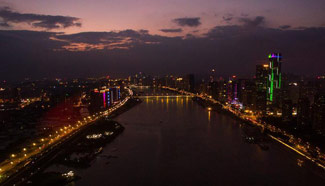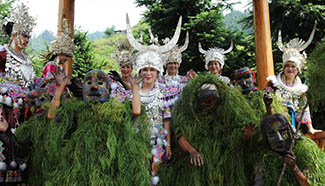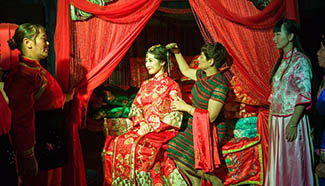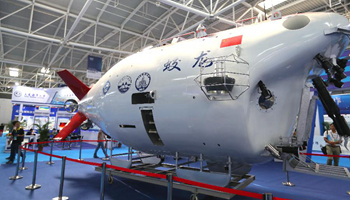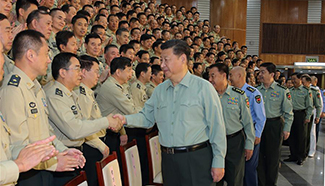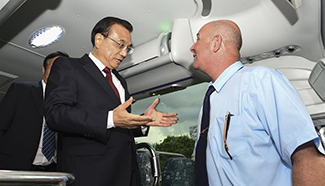BOGOTA, Sept. 26 (Xinhua) -- The Colombian government and the Revolutionary Armed Forces of Colombia (FARC), the country's largest rebel group, on Monday signed a historic peace deal that seeks to end 52-year armed conflict in the South American country.
The deal, signed by President Juan Manuel Santos and FARC leader Timoleon "Timochenko" Jimenez -- the nom de guerre for Rodrigo Londono -- in Colombia's Cartagena was finalized in the Cuban capital of Havana on Aug. 24.
In a plebiscite scheduled to take place on Oct. 2, Colombians will vote on whether they support the agreement or not.
The following is a chronology of Colombia's peace process over the past four years.
2012:
On Nov. 6, the government and rebel negotiators met face to face in Havana to lay the groundwork for peace talks.
On Nov. 19, the FARC marked the start of the historic talks by announcing a unilateral two-month ceasefire to begin on Nov. 20 and end on Jan. 20, 2013.
The next day, Colombia's then Defense Minister Juan Carlos Pinzon announced government security forces would continue to strike rebel targets despite the ceasefire.
2013:
On Jan. 21, a round of negotiations began between the government and the FARC and the group ended the ceasefire.
On May 26, a partial agreement was reached on agricultural development, one of the six points on the agenda.
On Nov. 6, a second partial agreement was reached on the political participation of former guerrillas.
2014:
On May 16, a partial agreement was reached on a solution to the fight against drug trafficking.
On June 15, President Santos was re-elected for four years with 50.9 percent of the vote after an intense campaign in which he pledged to seal a peace agreement.
On July 15, negotiations began concerning the victims of the conflict, surrounding three important themes: reparations, truth and justice.
On Aug. 21, the Historical Commission on the Conflict and Its Victims was formed.
On Nov. 16, talks were suspended after the FARC's 34th Front kidnapped Colombian General Ruben Dario Alzate.
On Nov. 30, General Alzate was released, along with two other hostages.
2015:
On Feb. 12: the FARC announced it would cease recruiting children under 17 into its ranks.
On March 7, the government and the FARC reached an agreement on a demining campaign to be carried out by the Colombian army, with the help of Norway.
On March 10, President Santos announced bombings of FARC bases would stop for a month.
On April 15, FARC members attacked an army unit in the southwestern department of Cauca, killing 11 soldiers. The government resumed bombing the campaign, leaving 26 rebels dead.
On May 23, the FARC declared an end to its unilateral truce.
On June 5, the Truce Commission was created to establish responsibility for crimes against humanity during the conflict.
On July 20, the FARC declared a new unilateral truce.
On July 25, Santos re-ordered suspension of the bombing campaign against the FARC.
On Sept. 17, the FARC announced their willingness to become a mainstream political movement.
On Sept. 23, President Santos and FARC leader Londono met in Havana. They signed a transitional justice agreement and stated that the peace agreement would be finalized by March 23, 2016.
On Oct. 17, negotiators agreed to work on a mechanism to alleviate the suffering of the families of the missing and agreed to exchange information about the victims of the conflict.
On Dec. 12, the government and the FARC announced that an agreement had been reached on the victims of the conflict. The guerrilla group agreed to apologize for its actions.
2016:
On Jan. 18, the Colombian government pardoned 30 FARC guerrilla fighters.
On Feb. 4, U.S. President Barack Obama said he would ask the U.S. Congress for more than 450 million U.S. dollars in aid for Colombia's peace process, through a new program named "Peace Colombia."
On March 1, Santos and Londono were nominated for the Nobel Peace Prize. The winner will be announced on Oct. 7.
On March 22, U.S. Secretary of State John Kerry met with the Colombian government and FARC negotiators in Cuba.
On June 22, the government and the FARC announced a deal on a definitive bilateral ceasefire, marking a major step towards ending the half-century conflict.
On June 23, Santos and Londono met in Cuba to sign a bilateral ceasefire.
On Aug. 24, a final peace agreement was reached and Santos addressed the nation to declare the war is over and that the Colombian people will vote in a plebiscite scheduled for Oct. 2 on whether to accept or reject the agreement.
On Aug. 25, President Santos delivered the definitive agreement with the FARC to Congress along with the report calling for a plebiscite.
On Aug. 30, President Santos announced the question that Colombians would need to reply "Yes" or "No" to in the plebiscite on Oct. 2 in order to approve or disapprove the agreement reached. "Do you support the final accord to end the conflict and build stable and lasting peace?"
On Sept. 17, the FARC began its 10th and final guerrilla conference, where the approval of the peace treaty was ratified.
On Sept. 25, the National Liberation Army, the country's second-largest guerrilla group, committed to establishing a unilateral ceasefire to guarantee that all Colombians are able to go out to vote peacefully on Oct. 2.


